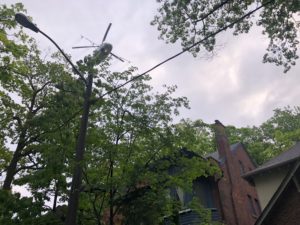On Wednesday, May 8th, Annabel Weinstein of the CLRA met with Josh Mckeekin and Joel Harrison-Off from the Toronto Forestry Department to discuss the upcoming gypsy moth spray program that will be undertaken over the next few weeks (May 16 – June 15), as well as some issues related to the health of the trees in our neighbourhood.
Both Josh and Joel were very generous with their information. They spoke to the challenges of replanting close to old stumps and changing frontages as old homes are renovated or rebuilt. We discussed how to engage the residents in understanding the importance of trees, not just as decoration but as being a part of our overall health. Forestry seems genuinely interested in working with us to help keep our neighbourhood healthy and beautiful. Their website is www.toronto.ca/trees
Gypsy moth is a major issue here. This pest has infiltrated our entire neighbourhood. Without the spray program to be undertaken, our trees will die. As it is, the trees are under severe stress because of overbuilding, of hard surfaces, such as driveways and patios, and from various climate events that have created a significant threat to just about every mature tree in the neighbourhood.
Because we live in a part of Toronto where most of the tree population is old and of one major species, the likelihood of an infestation of gypsy moth was inevitable. In addition, because of this lack of diversity and a similar age range of all of the trees, the effects of a gypsy moth infestation is greatly intensified.
The information about the spray being used by the city describes it as organic and non-toxic, except to gypsy moths. Some surfaces may feel a bit sticky right after but will not cause any damage to surfaces. The actual spraying procedure will take place on a morning, likely before 7:30 am, that offers good flight and spraying conditions. There will not be any harm caused to plants, gardens, pets or humans. The only casualties will be gypsy moths.
What is critical to note is that this spray campaign will not eradicate the gypsy moth problem forever. It will simply keep this pest at bay for 3-5 years. Individual home owners, who have mature oaks on their properties, should be following best practice procedures in the autumn of each year. Information for keeping gypsy moths at bay can be found in a Previous CLRA posting last June and on the City of Toronto website at www.toronto.ca/gypsymoth.
A key issue to keep in mind is that the large oaks in our neighbourhood are stressed. We must all do our parts to try to maintain our forest, which is one of the key attractions of our community, in as good a condition as possible. Please try to minimize the use of new hard surfaces that damage root systems and increase the chance of flooding. Review the procedures on the City of Toronto web site for advice on taking care of our trees and, when planting new trees on your property, consider diverse species that make it harder for pests to gang up on a single species.
Finally, the spray program will help. It will not harm you, your family, your pets or your gardens. You will likely not even be aware that the program has been undertaken.
Please, let’s protect one of our greatest assets. The big oaks have been here for hundreds of years. They have a story to tell and they help define our community by providing shade, oxygen and beauty.
If you have any questions or concerns, please let us know
UPDATE
One of the helicopter fly overs. This spraying took place at 7:00 am on Thursday June 6th

